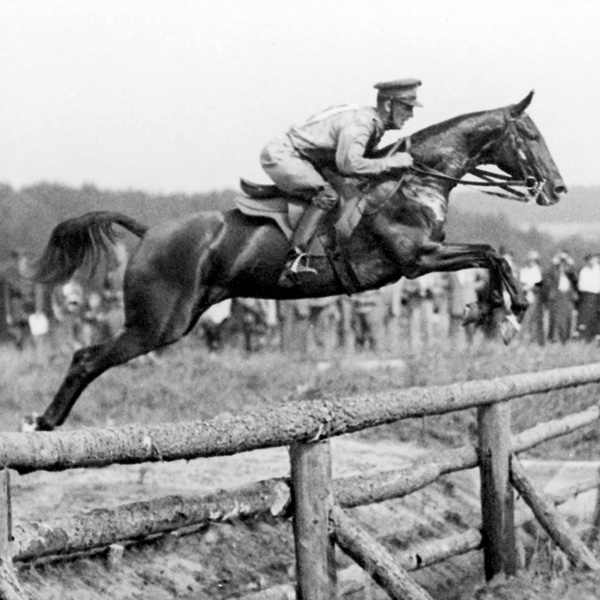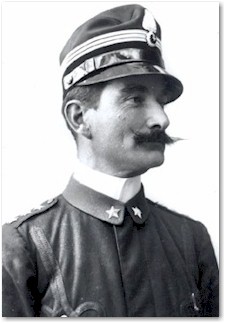 |
||
| Home About Us Photo Gallery Course Map Schooling Calendar Discussion Lessons & Training Horses Sale/Lease Balanced Seat Horsemanship Classes |
||
|
||||||||||||
|---|---|---|---|---|---|---|---|---|---|---|---|---|
| As the concept of the forward seat spread through most of the militaries of the western world it was varied, experimented with, and refined. During this period, roughly between 1910 and 1925, this new seat was known by many names. In America the name "Fort Riley Seat" was used. At the French Cavalry school in Saumur it was called the Saumur Seat, which particularly irritated the Italians, who responded by renaming the Forward Seat, the Italian Seat. The Russians, by the way, claimed that their Hussars had always ridden forward and that Caprilli had stolen the concept from them. The Germans, who incidentally managed to start a war with most of the western world during the time when the Forward Seat was introduced, rejected the new seat as a fad, but eventually in 1938 accepted it into their cavalry school. | ||||||||||||
 |
||||||||||||
By
the 1930’s it was clear that Caprilli’s Forward Seat was no fad, but rather
the most effective method for military riding, which required the greatest range
of demands on the horse and rider. In short, it kept soldier alive in the most
difficult mounted circumstances. It was not long that civilian riders were also
intent on learning this new method of riding. Retired cavalry officers traveled
the world to found riding schools to teach an eager public to ride in the new
Military Seat. As the new seat became the dominant civilian riding method the
name went through one more name change, and by 1940 it was almost universally
known as the Balanced Seat.
After
WWII America experienced a period of great prosperity. Leisure time became a new
industry, and horseback riding was on the rise as a popular sport for everyone.
If you began riding in America in the 1950s, as I did, you learned the Balanced
Seat, most often from a military trained instructor. George Morris for example learned from Gordon Wright, a chief instructor
at the Ft. Riley Cavalry School. Sally
Swift of Centered Riding fame received her instruction from a military rider,
and Susan Harris, author of all the Pony Club Manuals and related books,
received very high quality Balanced Seat instruction from military riders.
In
the 1960s in the shadow of the great post war economic boom, George Morris and
other well known riders tried to find a way to get more riders jumping and
showing quickly to satisfy the huge new interest in riding. They developed a
series of methods meant to speed up the learning process. The most well know of
these innovations was the crest release. In his August 2005 Practical Horseman
column, George Morris wrote that he and others who promoted these innovative
techniques never thought that their well intended short cuts would become
“endemic”, or that the crest release would “become and end in itself”.
Now
we see an extraordinary increase of interest in eventing. This interest creates
an interesting challenge for new or unsophisticated riders. They often assume in
ignorance that “English” disciplines are all alike and therefore that any
“English” riding instructor is qualified to teach them to ride in
preparation for eventing. It is in this circumstance that the inadequacies of the
Hunter/Jumper show seat become very apparent. Just as figure skating lessons would be dangerously adequate preparation
for ice hockey, instruction in the contemporary Hunter/Jumper show is inadequate
for eventing, or for that matter any equestrian sport outside the confines of a
flat fenced arena with evenly groomed footing.
While
Hunter/Jumper barns and instructors often use the term “balanced seat” to
describe their method, decades of stylized form and short cuts have moved the
Hunter/Jumper seat outside the realm of the original Balanced Seat and its
trademark effectiveness and military tradition. The true Balanced Seat is a
method of riding that was developed as eventing took form, and this method
remains today as the most effective in dealing with all the challenges of
combined training with its slopes, uneven footing, solid obstacles and grueling
distances. This is in sharp contrast to the Hunter/Jumper seat which is designed
only for impressing judges for a few minutes in a show ring. The two seats are, to say the least, quite different in terms of
effectiveness and should not be confused, particularly by eventing hopefuls.
More information on English seats: Seat Comparison
The
Balanced Seat is historically tied to dressage. At the French Cavalry School at
Saumur, military equestrian training was divided into two parts, dressage academique (high school dressage) and dressage sportif (dressage
applied to campaign or field riding).
The French Cavalry curriculum is one example of the strong
connection between the Balanced Seat and traditional dressage. Therefore,
another way to begin to ride in preparation for eventing is basic dressage.I do have one word of caution here.For some
dressage instructors it is a great challenge to view their dressage discipline as
merely one component of Combined Training. Instruction from purists of this
nature can be counter productive in developing a true Balanced Seat. However, there are
many dressage
instructors who enthusiastically teach eventers, fox hunters and others with
great pleasure, knowing their dressage skills will be applied to a broader spectrum of
equestrian sport.
Sally Swift’s books, while not focused in a particular seat are in my opinion excellent as well.
"Cavalry Manual of Horsemanship & Horsemastership” by Gordon Wright is a good place to start.
Harry Chamberlin’s books, “Training Hunters Jumpers and Hacks” and Riding and Schooling Horses” are classics, as are many books by Army Officers such as Beudant, Geoffrey Brooke, Noel Jackson, de Souza, S.G. Goldschmidt, Paul Holmelund, Vladimir Littauer, McTaggart, Santini, Timmis, and countless others. A student of the Balanced Seat will find that in equestrian literature the Balanced Seat is second only to dressage as the most written about seat in history.
Bob Wood 941 Longs Gap Road Carlisle PA 17013 717/243-8178 triplecreekfarm@gmail.com
